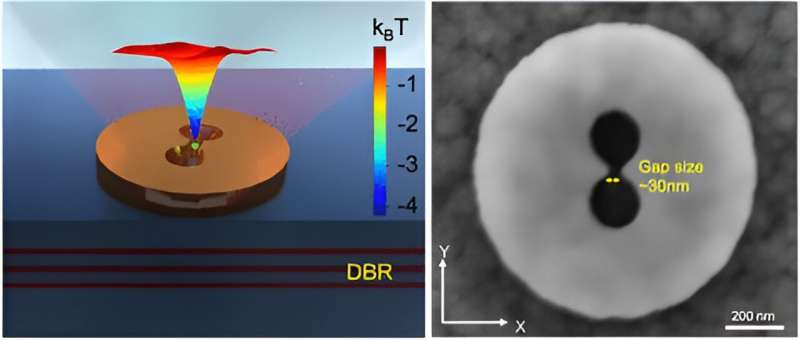
Justus Ndukaife, assistant professor of electrical and computer engineering at Vanderbilt University, is leading innovative research that more effectively traps nanosized extracellular vesicles and particles (EVPs) to analyze their roles in cancer, and neurodegenerative diseases.
The research, done in collaboration with the lab of Vanderbilt Professors Robert Coffey and Kasey Vickers, was recently published in Nano Letters.
EVPs—including recently discovered exomeres and supermeres—are thousands of times smaller than the thickness of a human hair. By trapping and manipulating them, researchers aim to better understand how cells package molecules and interact with one another, which may also shed light on the formation of diverse diseases, like cancer and Alzheimer’s.
However, when using optical tweezers, there’s a risk of photothermal heating that could adversely affect the EVPs. In their paper, Ndukaife and his team discuss using an anapole antenna to condense the electromagnetic energy to the nanoscale and successfully trap EVPs using a lower laser power.
“Since the proposed trapping system is low-loss, it precludes local temperature rises and thus ensures that important biological particles and molecules remain intact,” according to the paper.
The development of optical tweezers was recognized with the 2018 Nobel Prize in Physics for their efficacy in trapping single cells and larger EVs. Ndukaife developed the first-ever opto-thermo-electrohydrodynamic tweezer (OTET) that can trap and manipulate objects on the sub-10 nanometer scale at Vanderbilt in 2020.
More information:
Ikjun Hong et al, Anapole-Assisted Low-Power Optical Trapping of Nanoscale Extracellular Vesicles and Particles, Nano Letters (2023). DOI: 10.1021/acs.nanolett.3c02014
Journal information:Nano Letters
Provided by
Vanderbilt University

READ MORE
Why Do Humans Have Chins?
Illustration by Eric Palma In a nod to his striking bone structure, Jay Leno titled [...]
Visualizing temperature transport: An unexpected technique for nanoscale characterization
Credit: Tokyo Tech As devices continue to shrink, new challenges in their measurement and design [...]
Study shows that the ATLAS detector can measure the flux of high-energy supernova neutrinos
Muonspectrometer of ATLAS. Credit: CERN / Science Photo Library. High-energy neutrinos are extremely rare particles [...]
Contraceptive Gel Called the “IUD For Men” Makes It Through Monkey Trials
When it comes to reversible ways to prevent pregnancy, men have limited options—for now. Georges [...]
New technique to create thermally stable, high-entropy alloys
Enhanced thermal stability in the studied alloys with the addition of cobalt (0, 15, and [...]
How Do You Use Self-tapping Screws?
Self tapping screws are useful when dealing with materials that require constant maintenance. Kypros / [...]
How Gasification Works
The assistant director of Southern Illinois University’s Coal Research Center stands next to a model [...]
The National Zoo’s Beloved, Aging Emu Has Died
Darwin, described by caretakers as a bit “goofy,” befriended even the Zoo’s cassowary, widely considered [...]